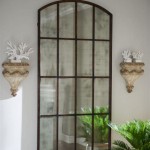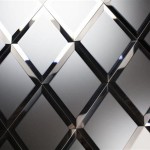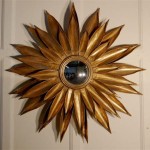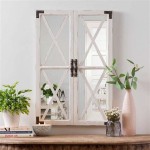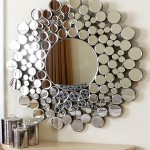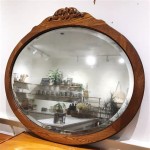How To Hang a Leaning Mirror On The Wall
Leaning mirrors offer a stylish and space-saving alternative to traditionally mounted mirrors. Their casual elegance suits various interior design styles, from minimalist to bohemian. However, ensuring stability and safety when hanging a leaning mirror requires careful consideration and proper techniques. This article provides a comprehensive guide to securely and effectively hanging a leaning mirror on the wall.
Choosing the Right Hardware
Selecting appropriate hardware is crucial for safely supporting the mirror's weight and preventing accidents. Consider the mirror's size and weight when choosing anchors and fasteners. For lighter mirrors, heavy-duty picture hooks or adhesive strips might suffice. However, heavier mirrors require more robust solutions, such as wall anchors specifically designed for heavier objects. Consult the packaging of the chosen anchors for weight limits to ensure they are suitable for the mirror.
Different wall materials necessitate different anchor types. Drywall requires specialized anchors that expand behind the wall surface for a secure grip. For masonry walls, concrete screws or masonry anchors offer the best hold. Identifying the wall type before purchasing hardware is essential for a secure and lasting installation. When in doubt, consulting a hardware store professional can provide valuable guidance on the best anchor type for the specific situation.
Securing the Mirror to the Wall
Once the appropriate hardware is selected, preparing the wall for installation is the next step. Mark the desired location for the top of the mirror on the wall using a pencil. Measure the distance from the top edge of the mirror to the hanging points on the back. Transfer these measurements to the wall, marking the points where the anchors will be installed. This precise marking ensures the mirror hangs straight and securely.
Install the chosen wall anchors according to the manufacturer's instructions. Ensure the anchors are flush with the wall surface. Some anchors require pre-drilling pilot holes, while others can be installed directly. Carefully follow the specific instructions for the chosen anchor type. Once the anchors are securely in place, attach the hanging hardware to the back of the mirror. Ensure screws are tightened firmly to prevent movement.
Carefully lift the mirror and align the hanging hardware with the installed wall anchors. Gently lower the mirror onto the anchors, ensuring it sits securely. Double-check that the mirror is level and stable. For added stability with larger or heavier mirrors, consider using safety chains or cables to connect the mirror to the wall. These additional safety measures provide extra protection against accidental tipping or falling.
Protecting the Wall and Mirror
Leaning mirrors, by their nature, rest against the wall, potentially causing scratches or scuffs. To prevent damage, applying protective padding to the back of the mirror where it contacts the wall is highly recommended. Felt pads, cork bumpers, or adhesive foam strips are suitable options. These materials cushion the contact point and prevent abrasive damage to both the wall and the mirror frame.
Maintaining a slight angle between the mirror and the wall further minimizes the risk of damage. This angle also enhances the leaning aesthetic. Adjusting the angle might require slightly different positioning of the wall anchors, so consider this factor during the initial marking process. Regularly inspect the padding for wear and tear and replace it as needed to maintain optimal protection.
Consider the surrounding environment when choosing the mirror's placement. Avoid placing leaning mirrors in high-traffic areas where they might be accidentally bumped or jostled. Likewise, avoid positioning the mirror directly under shelves or other objects that could fall and damage it. Thoughtful placement contributes significantly to the mirror's longevity and safety.
Alternative Hanging Methods
For lighter mirrors and specific wall types, alternative hanging methods can be employed. Strong adhesive strips designed for hanging pictures can be used for smaller, lightweight mirrors. Ensure the wall surface is clean and smooth for optimal adhesion. Follow the manufacturer's instructions for weight limits and application procedures.
Cleats offer another alternative, especially for larger mirrors. A cleat system consists of two interlocking pieces, one attached to the wall and the other to the back of the mirror. This system distributes the weight evenly and provides a secure hold. Cleats are particularly useful for heavier mirrors where traditional hanging methods might be less suitable. Choose cleats specifically designed for mirrors and follow the manufacturer's instructions for installation.

How To Hang A Heavy Full Length Leaner Mirror On The Wall House Of Hepworths

How To Hang A Heavy Full Length Leaner Mirror On The Wall House Of Hepworths

How To Hang A Heavy Full Length Leaner Mirror On The Wall House Of Hepworths

How To Hang A Heavy Full Length Leaner Mirror On The Wall House Of Hepworths

How To Secure A Heavy Leaning Floor Mirror The Wall Love Our Real Life

How To Secure A Leaning Mirror The Wall Diy Playbook

Where To Hang A Full Length Mirror Seriously Happy Homes

How To Hang A Heavy Full Length Leaner Mirror On The Wall House Of Hepworths

How To Hang A Large Floor Mirror Utr Decorating

Easy Ideas For Decorating With Floor Mirrors

